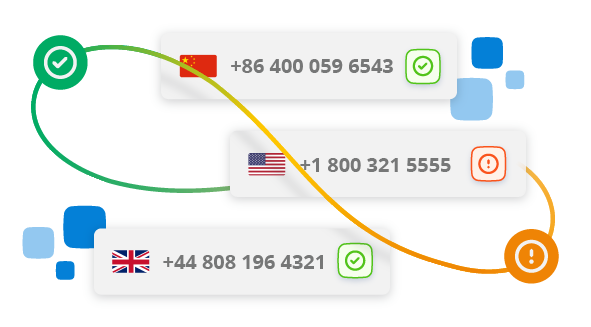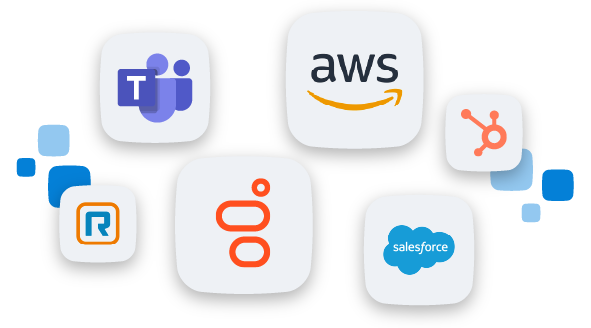Understanding Total Cost of Ownership of Voice in a Cloud World

As businesses embark on their cloud transformation journey, understanding your global voice solutions’s total cost of ownership (TCO) becomes crucial. While cyclical economic uncertainty may prompt conversations about cost management, most businesses focus on how cloud technology can enhance efficiency and deliver more value.
Moving to the cloud isn't just about doing more with less—it's about getting more with optimized resources. As you transition your voice services to the cloud, you'll find opportunities to streamline operations, improve scalability, and drive innovation, all while maintaining a keen eye on your bottom line.
In the following sections, we'll explore how cloud-based voice solutions can help you understand and optimize your TCO, providing insights into the nuanced world of cloud voice economics.
The Cloud Voice Landscape
The transition from traditional telephony to cloud-based voice solutions marks a significant shift in how businesses approach their communications infrastructure. Let's explore the various configurations organizations might adopt in their cloud journey:
On-Premise Setup
- Traditional infrastructure with physical hardware on-site
- High upfront costs and ongoing maintenance requirements
- Limited scalability and flexibility
Hybrid Solutions
- Combination of on-premise and cloud-based systems
- Allows for gradual migration to the cloud
- Balances existing investments with new cloud capabilities
- Difficult to create a uniform solution globally
Fully Cloud-Based
- All voice services hosted in the cloud
- Highly scalable and flexible
- Reduced hardware costs and maintenance
As you consider your setup, it's essential to understand how each configuration impacts your TCO. Cloud voice solutions offer the potential for significant cost savings and operational efficiencies, but the right approach depends on your specific business needs and existing infrastructure.
Understanding Total Cost of Ownership (TCO)
Total Cost of Ownership is a comprehensive view of the costs associated with your voice infrastructure throughout its lifecycle. It goes beyond the initial purchase price to include ongoing operational expenses, maintenance, and even the costs of potential service disruptions.
Breaking Down TCO Components
Acquisition Costs
- Hardware and software purchases
- Initial setup and configuration fees
- Integration costs
On-premise voice infrastructure can cost businesses between $800 to $1,000 per employee. That’s a lot of money upfront for technology requiring constant maintenance over its lifetime. Your stakeholders will want you to quantify its worth.
Can your legacy on-prem voice infrastructure do that?
Virtual voice platforms can provide the Return on Investment (ROI) goals your executive team expects of its department leaders. Hosted systems live in the cloud– removing physical equipment for web-based applications allows you to free up resources and cash flow that can be put toward other call investments.
But the beauty here is that cloud voice doesn’t have to replace your entire voice network infrastructure. It can also work with your existing system, giving it the modernization and enhancements needed to keep your business running efficiently and lower costs.
Operating Costs
- Recurring software licenses and subscriptions
- System maintenance contracts
- Cloud service fees
- Ongoing integration and API costs
VoIP is a scalable way to grow global voice and reduce TCO. Whether voice expansion via SIP, customizable call features, or automatic configuration, you’ll have confidence in the cloud’s reliability and quality control.
It’s changing the way business contact centers operate. With intuitive and self-service capabilities, your teams can operate more efficiently through call quality reports, order management, and carrier consolidation tools – plus more global voice reach.
Personnel Costs
- IT staff for management and maintenance
- Training and skill development
- Administrative overhead
Leveraging cloud voice providers with methodical onboarding programs, end-user training, and follow-the-sun support alleviates hefty resources allocated to troubleshooting, moves, add-ons, and changes in personnel costs. This, in turn, saves your business time and money and accelerates your team’s time to proficiency.
Service Interruption Costs
- Downtime and lost productivity
- Customer experience impact
- Potential revenue loss
On-premises voice systems face significant challenges when dealing with downtime and service interruptions. These systems often experience longer resolution times due to limited in-house expertise and can suffer from complete outages affecting all users simultaneously.
Manual processes for failover and recovery can extend downtime, mainly when hardware failures occur. On-premises solutions need help achieving true 24/7 monitoring and support, and the complexity of implementing comprehensive disaster recovery plans can leave businesses vulnerable to extended periods of disruption.
Cloud-based voice solutions typically feature redundant systems and automated failover processes, minimizing the likelihood and duration of outages. Specialized support teams and 24/7 monitoring enable faster issue resolution. The elastic nature of cloud infrastructure allows for consistent call quality and the ability to scale rapidly to meet fluctuating demand. This resilience helps maintain a positive customer experience even during challenging times. The global infrastructure of cloud providers enables true geographic redundancy and robust disaster recovery capabilities, ensuring business continuity.
Security Costs
- Toll Fraud
- Vishing
- TDoS
- PBX Hacking
- Robocalls
On-premises voice systems are inherently vulnerable due to their centralized nature, often presenting a single point of failure that can disrupt entire communication networks when compromised. This vulnerability is compounded by the limited scalability of security measures, making it difficult to adapt quickly to emerging threats or sudden increases in attack volume. Organizations face significant financial burdens in implementing robust redundancy and disaster recovery solutions to mitigate these risks.
Cloud-based voice solutions contrast their distributed architecture, significantly enhancing resilience against failures and attacks. This distributed nature allows for more effective load balancing and redundancy, minimizing the impact of localized issues. Cloud providers leverage economies of scale in their security investments, deploying cutting-edge protection measures that would be prohibitively expensive for individual organizations to implement on-premises.
Modern, more cutting-edge security software applications are typically cloud-based and easier to integrate with cloud voice infrastructure. Therefore, organizations can harden their security posture with a combination of applications that target specific security use cases based on business needs.
Understanding these components is crucial for making informed decisions about your voice infrastructure. Cloud solutions often shift costs from high upfront investments to more manageable operational expenses, potentially reducing your overall TCO.
Evaluating Voice TCO in the Cloud Era
In the cloud era, evaluating TCO requires a shift in perspective. While traditional on-premise solutions often have significant visible costs upfront, cloud solutions may have more distributed costs over time. 85% of total on-premise costs are hidden. We’re diving below the surface and uncovering these costs and what they mean to your business.
Here's how to approach TCO evaluation for cloud voice solutions:
Visible Costs
These are the acquisition costs incurred at the time of purchase. You can think of them as surface-level costs—ones detailed on your invoice statements.
- Monthly or annual subscription fees
- Per-user licensing costs
- API usage fees
Hidden Costs
These are the operating, personnel, and disruption costs associated with the remaining factors of TCO. The term "hidden" doesn't imply that the costs are intentionally invisible. Rather, buyers often overlook them.

- Repairs: Deploying security and patches to solve phone environment issues.
- Maintenance: Specialized personnel for equipment maintenance and troubleshooting.
- Upgrades: Adding new user licenses and calling features as business needs grow and develop.
- Service: Loss of productivity and performance due to connection downtime.
- Support: Ongoing support needs from internal departments or third-party providers.
- Security: 24/7/365 network management for on-premise and off-site server facilities.
- Training: Adequate training in new technologies and system upgrades
When evaluating cloud voice solutions, looking beyond the monthly fees is essential. Consider how the solution can drive efficiency, improve customer experiences, and support your business objectives. These factors all contribute to the true TCO of your voice infrastructure.
Strategies to Reduce TCO with Cloud Voice
Adopting cloud voice solutions offers numerous opportunities to reduce your TCO. Here are some strategies to consider:
Migrate on-prem to a cloud environment
Replatforming reduces the reliance on time-consuming phone system management and maintenance, allowing you to refocus on revenue-generating tasks.
Optimize cloud usage
Once you’ve moved your voice to the cloud, regularly review your usage patterns and adjust your subscriptions or plans accordingly.
Automate processes
Utilize self-service tools and automation to remedy audio quality issues, check phone requirements, organize billing groups, and send invoice notifications.
Consolidate services
Consider comprehensive platforms that can replace multiple-point solutions, reducing integration costs and complexity.
Govern security and compliance
Cloud tools use proactive monitoring techniques and encryption protocols to ensure compliance and health of network security.
Implement robust monitoring
Use analytics and monitoring tools to address issues and optimize performance proactively.
Invest in training
Ensure your team is well-versed in the cloud platform to maximize efficiency and reduce support needs.
Leverage flexible routing to always stay connected
Set up distinct disaster recovery and fail-safe rules to ensure your company is always operable, even when part of it goes offline.
Implementing these strategies can significantly reduce your TCO while improving your voice infrastructure's overall performance and capabilities.
Cost-Saving Tools in Cloud Communications
Cloud communications platforms offer a variety of tools that can help reduce costs and improve efficiency. Here are some key features to look for:
Call management and routing
- Intelligent call routing to optimize resource utilization
- Time-based routing to manage international calls efficiently
Analytics and reporting
- Detailed usage analytics to identify cost-saving opportunities
- Quality of Service (QoS) monitoring to preempt issues
Integration capabilities
- API access for custom integrations
- Pre-built integrations with standard business tools
Security features
- Built-in encryption and security measures supported with UDP, TCP, and TLS/sRTP layers
- Compliance tools to meet regulatory requirements
Scalability tools
- Easy addition or removal of users and services
- Flexible capacity planning features
These tools not only help reduce direct costs but also contribute to improved operational efficiency, ultimately lowering your TCO.
Choosing the Right Cloud Voice Solution
Selecting the right cloud voice infrastructure is crucial for optimizing your TCO. Here are key factors to consider:
Scalability
Ensure the solution can grow with your business needs.
Reliability
Look for providers with robust infrastructure and high uptime guarantees.
Global reach
If you operate internationally, choose a provider with strong global coverage.
Feature set
Ensure the platform offers the features you need now and may need in the future.
Integration capabilities
Consider how well the solution integrates with your existing systems.
Support and service
Evaluate the level and quality of support the provider offers.
Pricing model
Understand the pricing structure and how it aligns with your usage patterns.
Security and compliance
Ensure the provider meets your security requirements and industry regulations.
By carefully evaluating these factors, you can choose a cloud voice infrastructure that meets your immediate needs and provides long-term value and TCO benefits.
About the AVOXI Platform
The AVOXI Platform offers a comprehensive cloud communications solution designed to help businesses optimize their TCO while enhancing their global voice capabilities. Here's how AVOXI can help:
Simplified cloud communications
Easy migration from legacy systems with minimal disruption so that you can evolve your voice infrastructure, however it makes sense for your given situation.

Intelligent call routing
Make changes to your call flows more easily, mitigating time spent when changes are required.
Centralized management
Manage all your voice services from a single, intuitive platform.

Automated Number Connectivity Testing
Ensure your numbers are available with in-country testing done with software instead of a human activity.
Advanced analytics
Make data-driven decisions to optimize your voice infrastructure continually.
Global Coverage
Expand your reach with extensive international number availability.
Flexible integrations
Out-of-the-box connections with your existing contact center software with guardrails to ensure AVOXI is integrated quickly and correctly.

By leveraging the AVOXI Platform, businesses can reduce their TCO and gain a powerful tool for enhancing their global communications capabilities.
In conclusion, understanding TCO in the context of cloud voice solutions is crucial for making informed decisions about your communications infrastructure. By carefully evaluating your needs, leveraging the right tools, and choosing the appropriate cloud voice platform, you can optimize your TCO while positioning your business for future growth and innovation in the cloud era.


